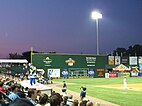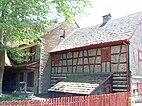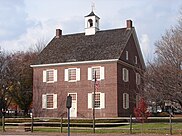
A | B | C | D | E | F | G | H | CH | I | J | K | L | M | N | O | P | Q | R | S | T | U | V | W | X | Y | Z | 0 | 1 | 2 | 3 | 4 | 5 | 6 | 7 | 8 | 9
York | |
|---|---|
| Nickname: The White Rose City | |
 Location of York in York County, Pennsylvania. | |
| Coordinates: 39°57′46″N 76°43′41″W / 39.96278°N 76.72806°W | |
| Country | |
| State | |
| County | York |
| Laid out | 1741 |
| – Borough | September 24, 1787 |
| – City | January 11, 1887 |
| Government | |
| • Mayor | Michael Helfrich (D)[1] |
| Area | |
| • City | 5.34 sq mi (13.84 km2) |
| • Land | 5.29 sq mi (13.71 km2) |
| • Water | 0.05 sq mi (0.13 km2) |
| Elevation | 367 ft (112 m) |
| Population (2020) | |
| • City | 44,800 |
| • Density | 8,389.5/sq mi (3,237.0/km2) |
| • Urban | 238,549 (US: 168th)[3] |
| • Urban density | 2,109.6/sq mi (814.5/km2) |
| • Metro | 456,438 (US: 121st) |
| Time zone | UTC−5 (EST) |
| • Summer (DST) | UTC−4 (EDT) |
| ZIP Codes | 17401, 17403–17405 |
| Area code(s) | 717 and 223 |
| FIPS code | 42-87048 |
| GNIS feature ID | 1215771[4] |
| Website | www |
York is a city in, and the county seat of, York County, Pennsylvania, United States.[5] Located in South Central Pennsylvania, the city's population was 44,800 at the time of the 2020 census, making it the tenth-most populous city in Pennsylvania.[6] The city has an urban area population of 238,549 people and a metropolitan population of 456,438 people.
Founded in 1741, York served as the temporary base for the Continental Congress from September 1777 to June 1778, during which the Articles of Confederation were drafted. It is the largest city in the York–Hanover metropolitan area, which is also included in the larger Harrisburg–York–Lebanon combined statistical area of the Susquehanna Valley.
History
18th century
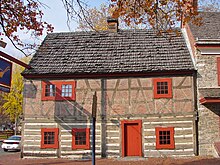
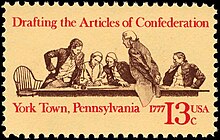
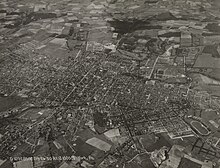
York was also known as Yorktown in the mid-18th to early 19th centuries. It was founded in 1741 by settlers from the Philadelphia region and named for the English city of the same name. By 1777, most of the area residents were of German or Scots-Irish descent.[7] It was incorporated as a borough on September 24, 1787, and as a city on January 11, 1887.
York served as the temporary base for the Continental Congress from September 30, 1777, to June 27, 1778, during the American Revolutionary War (1775–1783). Congress drafted and adopted the Articles of Confederation in York, though they were not ratified until March 1781. Congress met at the Court House that was built in 1754. It was demolished in 1841 and rebuilt in 1976 as Colonial Court House.[8][9]
York styles itself the first Capital of the United States, although historians generally consider it to be the fourth capital, after Philadelphia, Baltimore, and Lancaster (for one day).[10] The claim arises from the assertion that the Articles of Confederation was the first legal document to refer to the colonies as "the United States of America".[11] The argument depends on whether the Declaration of Independence would be considered a true legal document of the United States, being drafted under and in opposition to British rule. This does not, however, prevent modern businesses and organizations in the York area from using the name, such as the First Capital Dispensing Co., First Capital Engineering and First Capital Federal Credit Union.
The Conway Cabal was a political intrigue against General George Washington that originated in the Golden Plough Tavern in York.[12]
19th century
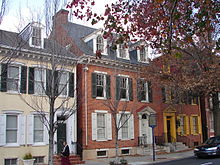
According to U.S. census reports from 1800 through 1840, York ranked within the nation's top one hundred most populous urban areas.
During the American Civil War (1861–1865), York became the largest Northern town to be occupied by the Confederate army when the division of Major General Jubal Anderson Early spent June 28–30, 1863 in and around the town while the brigade of John B. Gordon marched to the Susquehanna River at Wrightsville and back. Early placed York under tribute status and collected food, supplies, clothing, shoes, and $28,000 in cash from citizens and merchants before departing westward, obeying the revised orders of Robert E. Lee.
The sprawling York U.S. Army Hospital on Penn Commons served thousands of Union soldiers who had been wounded during the battles of Antietam and Gettysburg.[13]
During the Postbellum era (1865–1877), York remained a regional center for local agriculture, but increasingly became an important industrial center, with such industries as steam engines, railroad manufacturing, and papermaking achieving dominant status.
To this day, York still features unique architecture, ranging from colonial era buildings to large gothic churches.
20th century

The York Motor Car Co. built Pullman automobiles on North George St. from 1905 thorough 1917. An early and unique six-wheeled prototype was involved in one of the city's first known automobile accidents.[14] Another model was driven to San Francisco and back during roughly one month to prove its reliability several years prior to the creation of the Lincoln Highway which ran through town, connecting New York City and San Francisco.
The York area had also been home for more than 100 hundred years to the Pfaltzgraff company, which built its first pottery factory in the area in 1895 and continued manufacturing in York until 2005.[15]
Although currently produced by the Hershey Company, the York Peppermint Pattie was created in York in 1940.[16]
Throughout the middle of the 20th century, several incidents of racial prejudice and social injustices occurred in the city.[17] Between 1955 and 1970 there were several racial disturbances, most notably the 1969 York Race Riot, which resulted in the death of Lillie Belle Allen and Henry C. Schaad. These murders were largely left ignored until thirty-one years later, when allegations of murder and racial prejudice were raised against the mayor, Charlie Robertson.[18] Additionally, the city commonly held unopposed Ku Klux Klan rallies and public meetings, fostering further racial tension.[19] Though the murders of Allen and Schaad were solved and the perpetrators were apprehended, the actions, which originated back to the beginnings of the hate group, continue to the present day.[20]
21st century
In 2002, the city faced a budget shortfall of $1,000,000 (~$1.62 million in 2023). Mayor John S. Brenner's plan to raise the money by asking York County's 302,000 adult residents to donate $3.32 to the city received national attention.[21] The plan, referred to by some as the "Big Mac" Plan, did not raise all of the funds sought.
After many years of attempting to secure funding for a stadium and a baseball team to play in it, the first decade of the century saw York realize both goals. In 2007, Santander Stadium (now WellSpan Park), home of the York Revolution, opened in the Arch Street neighborhood. The stadium, along with other large projects such as the York County Judicial Center and the Codo luxury apartment lofts, have come to symbolize York's extensive redevelopment efforts.
Geography
According to the United States Census Bureau, the city has a total area of 5.3 square miles (14 km2), of which 5.2 square miles (13 km2) is land and 0.1 square miles (0.26 km2) (1.14%) is water.
Climate
York has a humid continental climate (Dfa) with hot, humid summers and moderately cold winters. The mean annual precipitation total of 41.1 inches (1,040 millimeters) is fairly evenly spread throughout the year, and falls on an average of 126.6 days per annum. Record temperatures from the York COOP range from 107 °F (42 °C), set on July 2, 1901, down to −21 °F (−29 °C), recorded on January 28, 1925, and January 21, 1994; at York Airport, with a considerably shorter period of record, the range is 100 °F (38 °C), set on July 22, 2011, down to −12 °F (−24 °C) as recently as March 6–7, 2015.[22] The York COOP also holds the official statewide 24-hour precipitation record of 13.5 in (340 mm) set on June 22, 1972, due to the impact of Hurricane Agnes.[23]
| Climate data for York, Pennsylvania (1991–2020 normals) | |||||||||||||
|---|---|---|---|---|---|---|---|---|---|---|---|---|---|
| Month | Jan | Feb | Mar | Apr | May | Jun | Jul | Aug | Sep | Oct | Nov | Dec | Year |
| Mean daily maximum °F (°C) | 41.2 (5.1) |
45.3 (7.4) |
54.5 (12.5) |
67.2 (19.6) |
76.5 (24.7) |
83.9 (28.8) |
87.7 (30.9) |
86.0 (30.0) |
79.7 (26.5) |
68.2 (20.1) |
55.7 (13.2) |
44.9 (7.2) |
65.9 (18.8) |
| Daily mean °F (°C) | 31.2 (−0.4) |
34.3 (1.3) |
42.4 (5.8) |
53.6 (12.0) |
63.1 (17.3) |
71.2 (21.8) |
75.4 (24.1) |
73.8 (23.2) |
67.1 (19.5) |
55.6 (13.1) |
44.4 (6.9) |
35.5 (1.9) |
54.0 (12.2) |
| Mean daily minimum °F (°C) | 21.3 (−5.9) |
23.2 (−4.9) |
30.2 (−1.0) |
40.0 (4.4) |
49.7 (9.8) |
58.5 (14.7) |
63.1 (17.3) |
61.5 (16.4) |
54.5 (12.5) |
43.0 (6.1) |
33.1 (0.6) |
26.1 (−3.3) |
42.0 (5.6) |
| Average precipitation inches (mm) | 3.27 (83) |
2.81 (71) |
4.01 (102) |
3.62 (92) |
4.20 (107) |
4.29 (109) |
4.52 (115) |
3.96 (101) |
5.10 (130) |
3.94 (100) |
3.22 (82) |
3.52 (89) |
46.46 (1,180) |
| Average snowfall inches (cm) | 8.5 (22) |
8.2 (21) |
3.9 (9.9) |
0.2 (0.51) |
0.0 (0.0) |
0.0 (0.0) |
0.0 (0.0) |
0.0 (0.0) |
0.0 (0.0) |
0.0 (0.0) |
0.5 (1.3) |
3.3 (8.4) |
24.6 (62) |
| Average precipitation days (≥ 0.01 in) | 10.3 | 9.6 | 11.6 | 11.6 | 12.7 | 12.0 | 11.0 | 9.6 | 9.6 | 8.4 | 10.0 | 10.5 | 126.9 |
| Average snowy days (≥ 0.1 in) | 3.3 | 3.0 | 1.7 | 0.2 | 0.0 | 0.0 | 0.0 | 0.0 | 0.0 | 0.0 | 0.3 | 1.5 | 10.0 |
| Source: NOAA[24][25] | |||||||||||||
Demographics
| Census | Pop. | Note | %± |
|---|---|---|---|
| 1790 | 2,096 | — | |
| 1800 | 2,503 | 19.4% | |
| 1810 | 2,847 | 13.7% | |
| 1820 | 3,107 | 9.1% | |
| 1830 | 4,216 | 35.7% | |
| 1840 | 4,779 | 13.4% | |
| 1850 | 6,803 | 42.4% | |
| 1860 | 8,603 | 26.5% | |
| 1870 | 11,003 | 27.9% | |
| 1880 | 13,940 | 26.7% | |
| 1890 | 20,793 | 49.2% | |
| 1900 | 33,708 | 62.1% | |
| 1910 | 44,750 | 32.8% | |
| 1920 | 47,512 | 6.2% | |
| 1930 | 55,254 | 16.3% | |
| 1940 | 56,712 | 2.6% | |
| 1950 | 59,953 | 5.7% | |
| 1960 | 54,504 | −9.1% | |
| 1970 | 50,008 | −8.2% | |
| 1980 | 44,619 | −10.8% | |
| 1990 | 42,192 | −5.4% | |
| 2000 | 40,862 | −3.2% | |
| 2010 | 43,718 | 7.0% | |
| 2020 | 44,800 | 2.5% | |
| U.S. Decennial Census[26][27] | |||
York is the largest principal city of the York–Hanover–Gettysburg CSA, a Combined Statistical Area that includes the York–Hanover metropolitan area (York County) and the Gettysburg micropolitan area (Adams County),[28][29][30] which had a combined population of 473,043 at the 2000 census.
As of the 2020 United States census, York had a population of 44,800, of which 38.1% were Hispanic/Latino, 32.4% were non-Hispanic White, 23.1% were non-Hispanic Black, 0.8% were Asian, 0.2% were Native American or Pacific Islander, and 5.4% were mixed or other.[31]
2010
As of the 2010 census,[32] the city was 51.2% White, 28.0% Black or African American, 0.6% Native American, 1.2% Asian, and 6.3% were two or more races. 28.5% of the population were of Hispanic or Latino ancestry.
2000
As of the census of 2000, there were 40,862 people, 16,137 households, and 9,246 families residing in the city. The population density was 7,852.2 inhabitants per square mile (3,031.8/km2). There were 18,534 housing units at an average density of 3,561.6/sq mi (1,375.1/km2).
The racial makeup of the city was 59.75% White, 25.13% African American, 0.42% Native American, 1.40% Asian, 0.07% Pacific Islander, 9.40% from other races, and 3.83% from two or more races. Hispanic or Latino of any race were 17.19% of the population.
There were 16,137 households, out of which 30.9% had children under the age of eighteen living with them; 31.0% were married couples living together, 20.6% had a female householder with no husband present, and 42.7% were non-families. 33.1% of all households were made up of individuals, and 10.7% had someone living alone who was sixty-five years of age or older.
The average household size was 2.48 and the average family size was 3.17.
In the city, the population was spread out, with 28.4% under the age of eighteen, 11.4% from eighteen to twenty-four, 30.1% from twenty-five to forty-four, 19.1% from forty-five to sixty-four, and 10.9% who were sixty-five years of age or older. The median age was thirty-one years.
For every one hundred females, there were 93.0 males. For every one hundred females who were aged eighteen or older, there were 88.0 males.
The median income for a household in the city was $26,475, and the median income for a family was $30,762. Males had a median income of $26,792 compared with that of $20,612 for females.
The per capita income for the city was $13,439.
Roughly 20.0% of families and 23.8% of the population were living below the poverty line, including 31.8% of those who were under the age of eighteen and 15.8% of those who were aged sixty-five or older.
Economy
York was the home of dental equipment and false teeth giant, Dentsply Sirona, until the company moved its headquarters to Charlotte, North Carolina in 2019.[33] Though founded in New York by four men, the company moved its headquarters to the site of its factory in the 1900s, where it was run by one of the four founders, George H. Whiteley. Whiteley was an experienced ceramist who was familiar with the process of making artificial teeth. Whiteley was sent by the group to oversee the factory and his family presided over the factory for multiple generations. Dentsply Sirona is a NASDAQ listed company, and internationally known throughout the dentistry business.[34][35][36]
York Barbell, which is located in Manchester Township, is a reseller of barbells and other equipment for weight training and bodybuilding, and is the home of the USA Weightlifting Hall of Fame.[37]
A large Harley-Davidson motorcycle factory, which employs roughly half of Harley's production workforce, is located just northeast of York in Springettsbury Township.
The York area is also home to two major manufacturers of modern hydro-power water turbines, Voith Hydro in West Manchester Township[38] and American Hydro in Hellam Township,[39] both of which manufacture enormous parts in their plants.
Spring Garden Township, directly south of York, is the headquarters to York International, a Johnson Controls Company and one of the largest suppliers of HVAC systems in the United States. On February 2, 1998, a massive explosion occurred at the York International plant. A spark set off a leak in the nearby propane storage house, causing a blast that was felt up to twenty-five miles away, which blew out windows nearby and knocked down doors. Roughly twenty people were injured, and one person was killed in the explosion, which occurred during a shift change.[40][41]
The Stauffer Biscuit Company, owned by Meiji Seika of Japan since February 2004, which was previously based in York, produced animal crackers since 1871; it is currently based in Spring Garden Township.[42]
Just north of York in East Manchester Township is one of only four Starbucks roasting facilities in the world.[43]
The York area also boasts a BAE Systems facility in West Manchester Township which assembles various military tanks and equipment.[44]
The P.H.Glatfelter paper company, founded in 1864, was headquartered in York until mid-2020 when it relocated to Charlotte, North Carolina. Glatfelter had sold its nearby Spring Grove paper mill in 2018.[45] The paper mill is now operated by Pixelle Specialty Solutions, LLC.
In addition, Christmas Tree Hill, a popular national Christmas, home decor and gift retailer, has been based in York since its founding in 1971. Its flagship location is housed in the historic Meadowbrook Mansion, which was built in East York during the early 1800s.[46] The six columns on the mansion's front porch were reused from the second York County Courthouse cupola, which had been located at 28 East Market Street from 1841 until it was taken down in 1898 to make room for the third courthouse.[47]
Arts and culture
Architecture
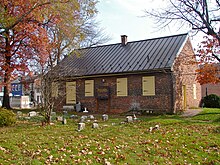
Historic sites include the 1741 Golden Plough Tavern,[48] the 1751 General Horatio Gates House,[49] the 1766 York Meetinghouse,[50] the 1863 Billmeyer House,[51] the 1888 York Central Market,[52] and the 1907 Moorish Revival Temple Beth Israel.
Other notable buildings include the Laurel-Rex Fire Company House, Forry House, Farmers Market, Barnett Bobb House, Cookes House, United Cigar Manufacturing Company building, Stevens School, York Dispatch Newspaper Offices, and York Armory.[53]
The city is also home to four national historic districts: Fairmount Historic District, Northwest York Historic District, Springdale Historic District, and York Historic District.[53]
Fairgrounds and vendors
Much of York's culture represents the city's evolving role as an agricultural and industrial center. The historic York State Fair, which claims to be the country's oldest,[54] traces its roots to 1765. It runs every year in late July for ten days, encompassing an entire week and two weekends. In addition to typical fair attractions, such as rides, games and contests, it also wins regional recognition for hosting many musical artists, such as Alabama, Gretchen Wilson, Carrie Underwood, Toby Keith, and Lynyrd Skynyrd.[55][56][57]
The fairgrounds, branded the York Expo Center, also hosts the annual National Street Rod Association Street Rod Nationals East, the largest annual street rod event in the Eastern US.[58] The event brings thousands of street rods into the city for a few days in June. On Friday afternoons of the event, the city holds a parade through the center of the city for participating vehicles.
York City Recreation and Parks helps sponsor the Olde York Street Fair[59] each year on Mothers Day, the second Sunday of May – a tradition since the early 1980s. In recent years, more than 150 art, craft and food vendors have lined Market and George streets. Average attendance was 60,000 people as of 2004, according to city officials.[60]
Theatre

York is home to DreamWrights Center for Community Arts, The Belmont Theatre, the Pullo Center at Penn State York and the Appell Center for the Performing Arts, formerly known as the Strand-Capitol Performing Arts Center, which hosts nationally acclaimed acts in York. Performers here have included Kenny G, Bill Cosby,[61] B.B. King,[62] Béla Fleck,[63] and George Carlin.[64]
The historic Capitol Theatre also features many independent and foreign films, making it the only venue in York (and sometimes the entire Susquehanna Valley) to feature some rare, yet critically acclaimed films. The Strand Studio has also branched out and offers live music, usually jazz and acoustic, for the community. In 2017, DreamWrights underwent the largest renovation in its twenty-year history, adding a second performance space among other improvements.[65]
Heritage
The York County History Center (YCHC) is a not-for-profit educational institution that preserves and uses its collections, historic sites and museums to encourage exploration of the history and culture of York County, Pennsylvania. YCHC maintains eight historical sites that demonstrate three hundred years of York County's history. The YCHC was founded in 1999 after a merger of the Historical Society of York County and the Agricultural and Industrial Museum of York County (AIM). Currently, the YCHC historical sites include the Worker's House, which was erected circa 1875, the Golden Plough Tavern, which was built sometime around 1741, the Barnett Bobb Log House, which was erected in 1812, the Bonham House, which was built circa 1885, and the old Eastern Market House, which was erected sometime around 1886.
In 1992, AIM acquired an industrial complex consisting of six buildings, which were built roughly between 1874 and 1955; three of the buildings were renovated and now house the industrial portion of the collection. The YCHC also hosts a variety of events throughout the year and holds the rights to the Murals of York, a group of paintings that depict York's history.
The History Center also purchased a former Met-Ed steam plant in York in late 2015 and plans to turn it into a new history center. In 2016, what was the York County Heritage Trust rebranded as the York County History Center.[citation needed]
Music

The York Factory Whistle holds the world record for the loudest music without amplification from a non-musical instrument.[66] Every Christmas Eve, the whistle uses a compressor to create air pressure, then releases it through a series of tubes using a device much like a slide whistle. (Prior to 2010, the pressure was created using steam produced by a boiler.) The music has had a loudness of 140 dB and can be heard ten to twelve miles away with proper weather conditions. Christmas music is played for a short time around midnight. It is thought that this annual tradition was started around 1925.[67][68][69] Other sources date the tradition circa 1888 or earlier.[70]
After the New York Wire Cloth Company plant closed in 2013, Metso moved the whistle to its factory in York and continued the annual concert tradition.[71] Metso announced in August 2015 that it would close its York plant by the end of March 2016.[72] As of December 2017, the building was still owned by Metso and the annual twenty-five-minute York Factory Whistle Concert remained scheduled, along with two daytime rehearsal sessions.[73]
By December 2018, the hosting factory building was owned by 240 Arch LLC, and the air compressor (to be moved there for rehearsals and the concert) was trailer-mounted.[70] Another early Christmas concert and Saturday-before practice were announced for 2019.[74]
The alternative rock band Live is from York.[75] Many of Live's songs are about the town including "Shit Towne" from their most successful album Throwing Copper.[76]
Several community bands that formed during the 19th and early 20th centuries continue to perform in York as it is the closest city to the groups. They include the Emigsville Band of Emigsville, Spring Garden Band of Spring Garden Township, Brodbecks Band of Jefferson, Red Lion-Felton Band of Red Lion, and Twin Rose Community Band of Wrightsville.[77]
York is home to many veteran as well as up-and-coming talented artists and musicians from all genres including funk, blues, jazz, rock, experimental, country, and bluegrass. The rock band Hexbelt is known for its brand of "Susquehanna Hexbelt Swing" music.[78] York hosts a variety of open mics and underground venues such as the Sign of the Wagon[79] and The Depot.[80] Astro Lasso, an electronic indie pop band from York managed by Frankie Muniz, toured with We the Kings in 2017.[81]
The York chapter of the Barbershop Harmony Society, performing as the White Rose Chorus, was founded in 1945.[82]
Shopping
The area's main shopping centers are York Galleria and West Manchester Town Center.


